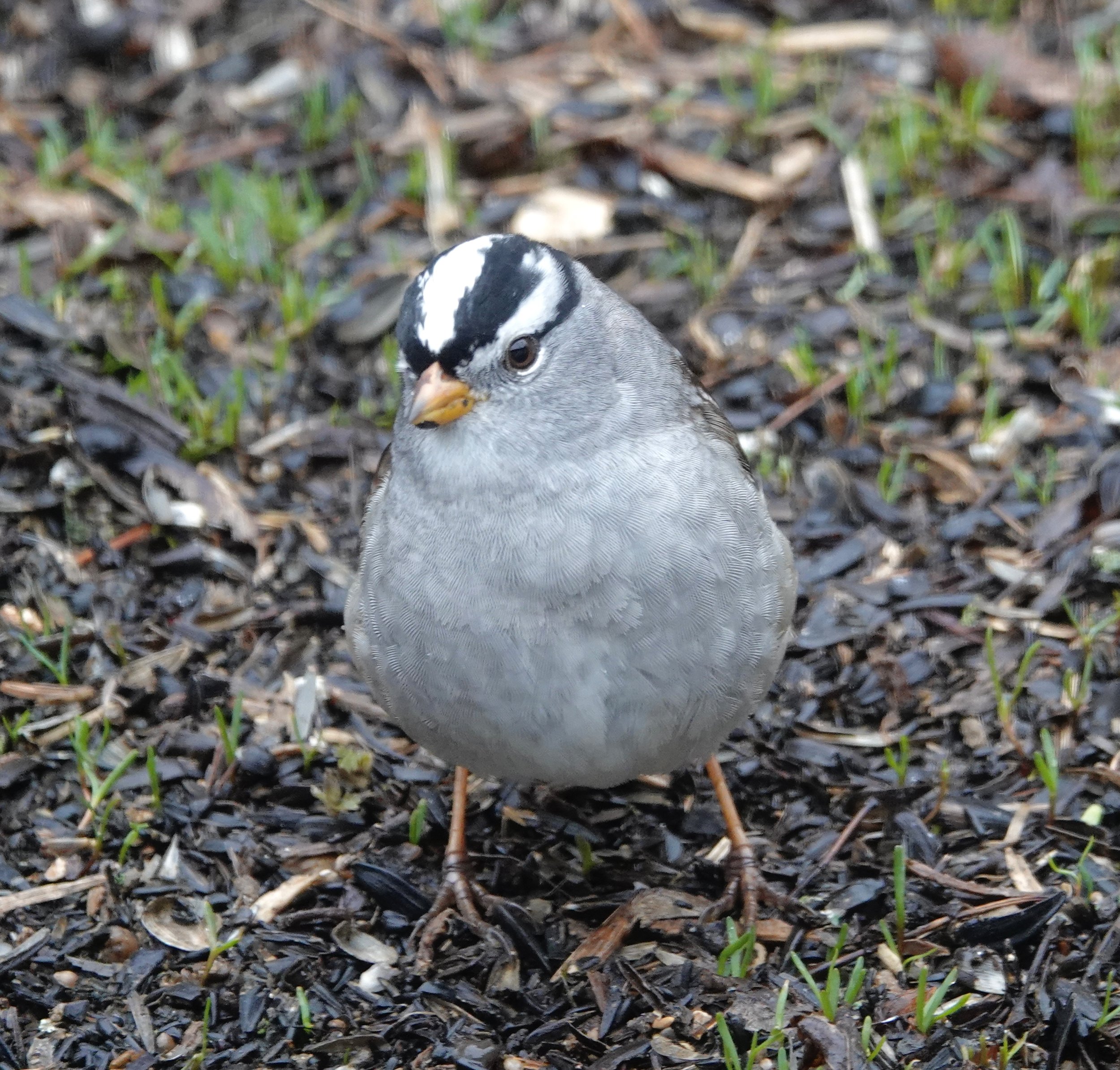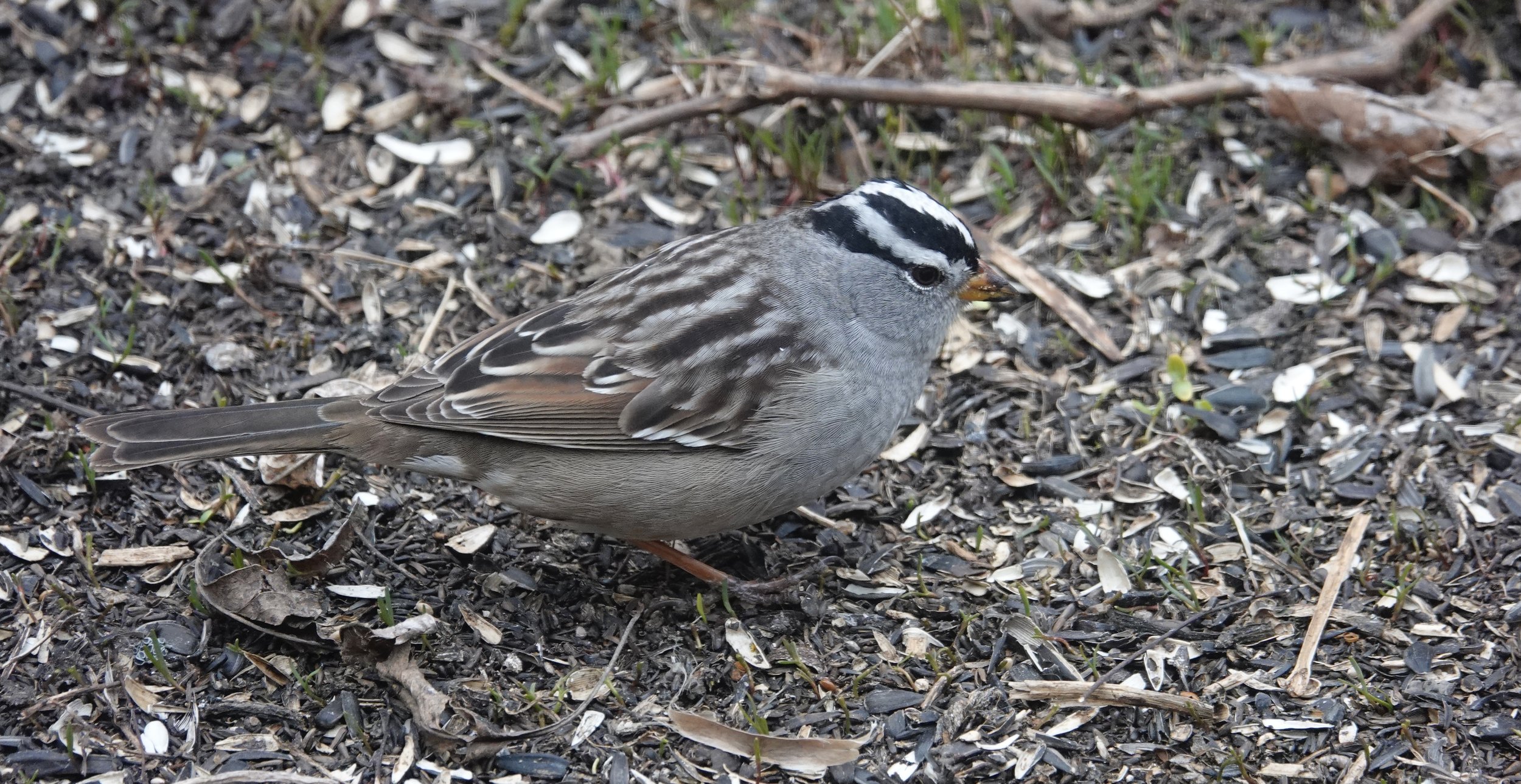The Hermit Thrush is a lovely singer and likely gets its name because of its retiring ways. Photo by Al Batt.
Naturally
Birds are a handle for me to hold on to. The goldfinches become more lemony each day, tree swallows (spring on the wing) slice the air, and juncos persist in high numbers in my yard. Amid this junco jubilation and chorus frog caroling are fox sparrows, brown thrashers, white-throated sparrows, song sparrows, robins and a hermit thrush busily feeding. It’s a rare leaf resting on the ground that hasn’t had its butt kicked by all that scratching, flipping and tossing. It’s as if an avian The Who were playing a version of “The Chicken Dance” while smashing their guitars.
I rejoiced in the return of brown thrashers. The birds are masters of imitations and invention in their songs. Many folks are familiar with the northern mockingbird commonly seen and heard in much of this country. Brown thrashers typically repeat phrases only twice, while mockingbirds repeat theirs three or more times. Brown thrashers and gray catbirds hit the shuffle button.
My overlords, the squirrels, ate heartily. What would the people selling bird feeders do without squirrels? They ensure repeat customers. Squirrels live every day as if it’s their first.
Robins sing earlier some evenings than others. They time their singing to the intensity of light and time of sunset. When dark clouds roll in, they sing earlier. From sunset until dark, a robin adds ethereal whispered notes to its carol, creating a song of remarkable complexity. The American robin is one of the first bird species to sing each morning before the dawn chorus starts and one of the last ones to sing in the evening. Studies have found it sings the least around noon. A robin’s crepuscular singing may correlate with the physiology of its eyes, which are adapted to low-light environments, like dawn and dusk. In locations with more artificial light, robins initiate their morning songs earlier than in darker areas. Whispered syllables are frequently heard during dawn and dusk. The primary reason males sing is to attract a mate and to establish and defend a territory.
I enjoy counting raptors as I drive—mostly red-tailed hawks and American kestrels. An osprey looked large in the air, with its distinctive kink in its wings. I spotted a northern harrier male, a gray ghost of the marsh. It was once called a marsh hawk. I see them gliding low over a field as they hunt. This raptor has a white rump at the base of its tail. The females are brown.
I watched specklebellies (greater white-fronted geese) fly overhead and smiled at their laughing calls sounding strangely human. The belly of the goose is grayish with dark brown to black blotches and bars, giving it the nickname "specklebelly” or “speckled belly.”
I see organized groups culling our ditches of trash. They do good work. I pick up trash when I’m birding and have for so many years I can’t remember when I didn’t. I can’t pick it all up and I don’t try. I can pick up some of it and I do. One day, I found an entire pen. It hadn’t been crushed by a vehicle tire. It didn’t have any ink, but you can’t have everything. A woman asked me why I was picking up trash. She likely thought I’d been sentenced to community service. “I am birding,” I said.
I was on a long drive home from a speaking engagement. My journey was nothing compared to the migration of the bar-tailed godwit. Individuals of that species have traveled over 8100 miles without food or rest. How do birds know when to migrate? Day length, food availability, weather, temperature, body condition, other birds are migrating and Zungunruhe (a migratory restlessness).
Q&A
“How long is a chipmunk’s burrow?” The cute little eastern chipmunk with his cheeks stuffed with food has a burrow that reaches 2 feet deep and 30 feet long.
“What is Minnesota’s heaviest flying bird?” Weighing in at over 25 pounds, the trumpeter swan is the heaviest bird flying in North America.
“I see eagles by my cabin in northern Minnesota. Could they be golden eagles?” They would be immature bald eagles, which are the same size. Golden eagles don’t breed in Minnesota, but are regular winter residents of the blufflands region of southeast Minnesota.
“What kind of birds might be nesting in a bluebird nest box?” Bluebirds, tree swallows, black-capped chickadees, house wrens and house sparrows. Use a 1 9/16-inch entrance hole for bluebirds and 1 1/8-inch for chickadees.
Thanks for stopping by
“Every creature is better alive than dead, men and moose and pine trees, and he who understands it aright will rather preserve its life than destroy it.”—Henry David Thoreau.
“To look at any thing, if you would know that thing, you must look at it long.”—John Moffitt.
Do good.
©Al Batt 2022
I love a lemony American Goldfinch.
The damage done to Hartland, Minnesota, in December’s tornado are evident.
I hope the lovely mural endures.
When it comes to fishing, some of us (I’m talking about you, American White Pelicans) get carried away.
When it comes to fishing, some of us (I’m talking about you, American White Pelicans) get carried away.
A White-crowned Sparrow looks as if it’s wearing a bike helmet.
A White-crowned Sparrow looks as if it’s wearing a bike helmet.
My walk was a leaf-covered mosey. One of the leaves turned out to be a Mourning Cloak butterfly. I watched it as it flew to a place where it could feed on tree sap. This handsome creature hibernates as an adult.
Kids built this along a walking/bike trail. They were probably taking a class from a beaver.
In Rochester, Minnesota.
I’m seeing Red Admiral butterflies. They enjoy feeding on tree sap.
Spring radio.
These Common Loons spend the year here.
















